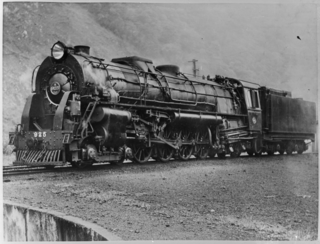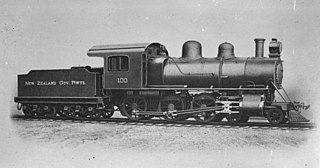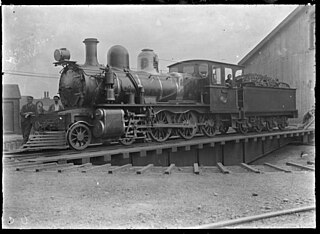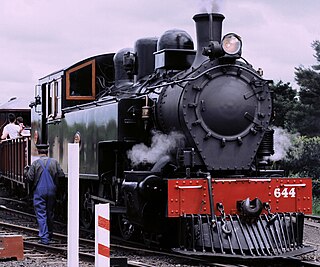
The NZR K class of 1877 was the first example of American-built locomotives to be used on New Zealand's rail network. Their success coloured locomotive development in New Zealand until the end of steam.

The NZR A class of 1873 consisted of three types of steam locomotives used on New Zealand's railway network of similar specification but differing detail. The first and most numerous were from the Dübs and Company, the next from the Wellington firm E.W. Mills Lion Foundry, and the last from the Scottish firm of Shanks. The specifications are for the Dubs Yorkshire engines.

The NZR A class were a class of steam locomotives built in 1906 with a 4-6-2 wheel arrangement for the New Zealand Railways Department (NZR). The class should not be confused with the older and more obscure A class of 1873. They were designed by the NZR's Chief Mechanical Engineer, A. L. Beattie and his Chief Draughtsman, G. A. Pearson to replace less powerful locomotives struggling with increasing loads on the South Island Main Trunk Railway, and in anticipation of the traffic volumes that would be created upon the completion of the North Island Main Trunk railway.

The NZR AB class was a class of 4-6-2 Pacific tender steam locomotive that operated on New Zealand's national railway system for New Zealand Railways (NZR). Originally an improvement on the 1906 A class, 141 were built between 1915 and 1927 by NZR's Addington Workshops, A & G Price of Thames, New Zealand, and North British Locomotive Company, making the AB class the largest class of steam locomotives ever to run in New Zealand. An additional eleven were rebuilt from the tank version of the AB – the WAB class – between 1947 and 1957. Two North British-made locomotives were lost in the wreck of the SS Wiltshire in May 1922.

The NZR AA class consisted of ten steam locomotives built by Baldwin Locomotive Works in 1914 to an order by Chief Mechanical Engineer, H. H. Jackson for operation on New Zealand's national rail network.

The NZR NC class was a class of two steam locomotives built by Baldwin Locomotive Works built for service on New Zealand's private Wellington and Manawatu Railway (WMR). They did not acquire their NC classification until the publicly owned New Zealand Railways Department (NZR) purchased the WMR and its locomotive fleet.

The NZR B class of 1899 was a class of steam locomotives that operated on New Zealand's national rail network. An earlier B class of Double Fairlies had entered service in 1874, but as they had departed from the ownership of the New Zealand Railways (NZR) by the end of 1896, the B classification was free to be re-used. Despite early difficulties, they were amongst NZR's most influential designs.

The NZR BB class of steam locomotives comprised 30 engines operated by the New Zealand Railways (NZR) in the North Island of New Zealand. Ordered to replace smaller locomotives of several classes in the North Island, they were similar in design and appearance to the preceding B and BA classes. The first BB class locomotive entered service in February 1915, with the last to commence operations doing so on 8 March 1917. All were built by A & G Price Ltd of Thames, New Zealand, and as their cylinders had a larger diameter than the B and BA locomotives they were capable of generating more power to haul heavier trains. The most visible difference however was the roundtop firebox in place of the preceding classes Belpaire design. The BB class could haul up to 700 long tons of freight on a level railway line, though they were limited to a top speed of around 40 mph (64 km/h).

The BC class comprised a single steam locomotive that operated on New Zealand's national rail network. Built for the Wellington and Manawatu Railway (WMR) and classified as No. 17, it passed into the ownership of the New Zealand Railways Department (NZR) when the government purchased the WMR in December 1908, and it was then that it acquired the BC classification as BC 463.

The NZR WAB class locomotives were steam locomotives designed, built and used by New Zealand Railways Department (NZR). Their wheel arrangement is described by the Whyte notation 4-6-4T. The locomotives were designed by NZR chief draughtsman S.H. Jenkinson as tank versions of the AB class 4-6-2 Pacific locomotive. Initially, the locomotives were separated into two classes, designated WAB for mainline work and WS for suburban work.

The NZR JA class was a class of fifty-one 4-8-2 steam locomotives operated by the New Zealand Railways Department (NZR). The locomotives were built in two batches; the first batch was constructed in-home at the Hillside Workshops at Dunedin between 1946 and 1956, while the second batch was produced by the North British Locomotive Company (NBL) of Glasgow, Scotland in 1951. To differentiate between the two batches, the locomotives were identified by their builder.

The NZR K class of 1932 was a class of mixed traffic 4-8-4 steam locomotives built by the New Zealand Railways Department (NZR) that operated on New Zealand's railway network. The locomotives were developed following the failure of the G class Garratt locomotives. The class should not be confused with the much earlier K class of 1877-78, the first American-built engines to arrive in New Zealand.

The NZR G class was a type of Garratt locomotives used in New Zealand, later rebuilt as Pacific type locomotives. They were the only Garratt type steam locomotives ever used by the New Zealand Railways (NZR). They were ordered to deal with traffic growth over the heavy gradients of the North Island Main Trunk (NIMT) and to do away with the use of banking engines on steep grades. They were one of the few Garratt designs to employ six cylinders. A mechanical stoker was used to feed coal into the locomotive. The locomotives lasted longer in rebuilt form as standard Pacific locomotives than they did as Garratts, but their numerous mechanical issues lead to their final withdrawal following a union ban on their use in 1956.
Alfred Luther Beattie, typically referred to as A. L. Beattie, was a pioneering locomotive engineer. Born in Yorkshire, England, he gained fame as the Chief Mechanical Engineer of the New Zealand Railways Department (NZR) between 1900 and 1913. During this time, Beattie designed the Q class, the first 4-6-2 (Pacific) steam locomotive class in the world, and he was also one of the earliest people to use other wheel arrangements.

The NZR W class consisted of two steam locomotives built at the Addington Railway Workshops in Christchurch, New Zealand by the New Zealand Railways Department (NZR). They were the first locomotives to be built by NZR.

The NZR U class, the first tender locomotives built in New Zealand, were a class of 4-6-0 Ten Wheeler locomotive designed to the requirements of Mr T. F. Rotherham and built at NZR Addington between 1894 and 1903. They were amongst NZRs' longest lived tender engines.

The NZR UA class were a class of 4-6-0 Ten Wheeler locomotive built by the Scottish firm of Sharp Stewart and Company to ease a motive power shortage. They lived relatively short lives amongst NZR ten wheelers, mostly at the southern end of the country where they were seldom photographed.

The NZR UB class were a series of Ten Wheelers built by American manufacturers for New Zealand Railways (NZR) around the start of the twentieth century. Two batches were built by Baldwin in 1898 and 1901. The earlier engines had slide valves and inside Stephenson motion, the later had piston valves and Walschaerts valve gear, as well as a higher boiler pressure.

The NZR UC class were a group of ten 4-6-0 steam locomotives obtained from Scottish builders Sharp, Stewart and Company for New Zealand Railways (NZR). Essentially they were developments of the firm's previous batch of 4-6-0s' for NZR.

The NZR WW class was a class of 4-6-4T tank locomotives that operated on the New Zealand national railway network. They were built for New Zealand Railways Department (NZR), and were the final development of the six-coupled tank engine in New Zealand, the penultimate class of tank locomotives to be built for NZR, and the first class of tank locomotives to be built with superheaters.



















